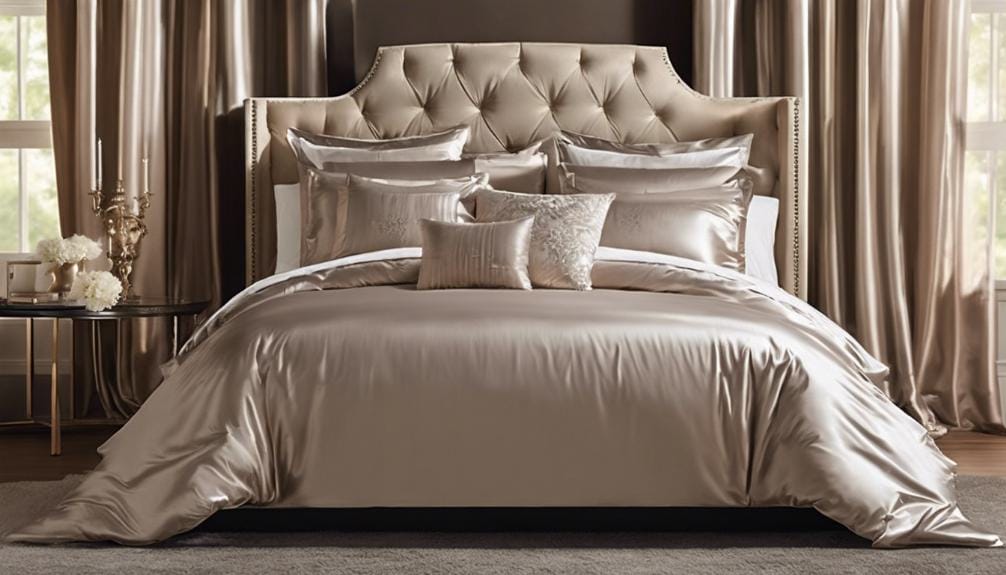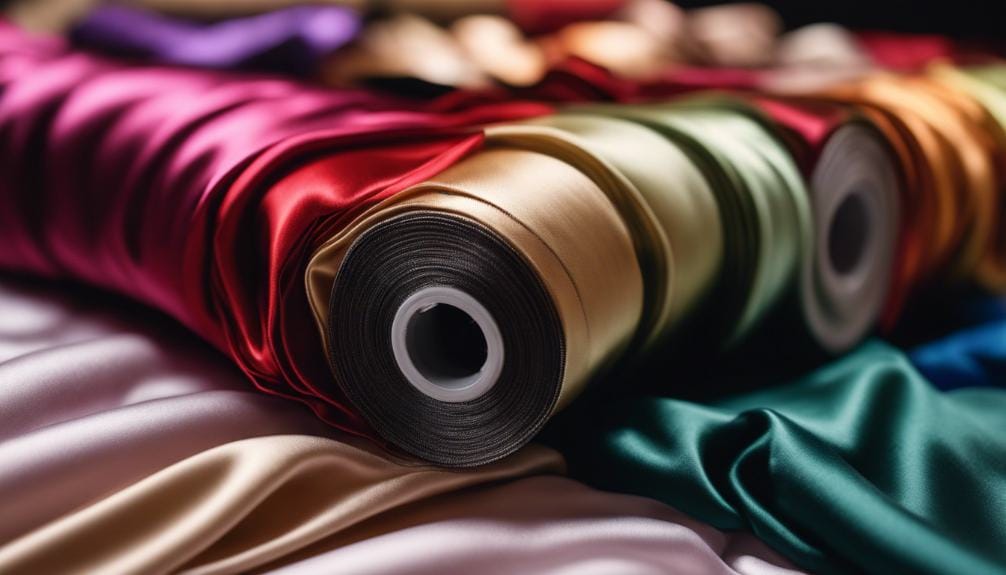What Are Satin Sheets? A Comprehensive Guide
Explore the world of satin sheets, crafted from a blend of rayon and synthetic fibers for a smooth, luxurious touch. These sheets boast a silky feel and shiny finish, ideal for a cozy slumber. They are hypoallergenic, regulate temperature, and easy to maintain. Choose polyester for affordability or silk for supreme comfort and breathability. Quality hinges on thread count, material composition, and weave type. Maintain them by using gentle wash cycles and drying methods. Dive deeper to uncover the nuances of satin sheet weave types and design options for an even more indulgent bedding experience.
Satin Sheets: Material and Characteristics
When selecting satin sheets, ponder their material and characteristics to guarantee a soft and luxurious sleeping experience.
Satin sheets are made from a blend of rayon and synthetic fibers, offering a silky feel with a lustrous finish. Their weave pattern creates a shiny and smooth texture.
These sheets are hypoallergenic, moisture-wicking, and regulate body temperature.
Satin sheets are durable and easy to maintain, providing a comfortable and elegant sleeping environment.
Choosing Between Polyester and Silk
When deciding between polyester and silk for your satin sheets, consider your budget and the level of comfort you seek.
- Polyester sheets are budget-friendly.
- Silk sheets offer superior comfort and breathability.
- Polyester is less breathable than silk.
- Silk is hypoallergenic, ideal for sensitive skin.
Make your choice based on budget, comfort needs, breathability, and skin sensitivity.
Factors Impacting Satin Sheet Quality

To evaluate the quality of satin sheets, one must carefully consider various factors that encompass thread count, material composition, weave type, dyeing process, and manufacturing quality control. These elements play an essential role in determining the overall feel, durability, and luxury of your satin sheets. Here is a table summarizing the key factors impacting satin sheet quality:
| Factor | Impact |
|---|---|
| Thread Count | Indicates smoothness and luxury |
| Material Composition | Affects quality and performance |
| Weave Type | Influences texture and appearance |
Care Tips for Maintaining Satin Sheets
Considering the factors that impact satin sheet quality, it’s imperative to adhere to proper care tips to maintain the luxurious feel and longevity of your sheets.
- Use enzyme-based stain removers before washing to tackle tough stains effectively.
- Wash in cold water on a gentle cycle to prevent damage.
- Avoid washing with other items to prevent snags.
- Dry on low settings or air-dry to maintain softness.
Weave Types and Design Options

Exploring the various weave types and design options of satin sheets reveals the unique characteristics and luxurious feel each option provides. Satin weave creates a smooth surface with a shiny appearance, enhancing the bedding quality. Sateen weave offers even softer and more lustrous sheets, while charmeuse weave, often used for silk sheets, provides a highly desirable luxurious feel. The weave types greatly impact the overall feel and appearance of these lustrous sheets.
| Weave Type | Characteristics | Feel |
|---|---|---|
| Satin weave | Smooth, shiny surface | Luxurious |
| Sateen weave | Soft, lustrous sheets | Comfortable, elegant |
| Charmeuse weave | Luxurious, silky feel | Highly desirable |
Frequently Asked Questions
What Are Satin Sheets Good For?
Satin sheets are great for providing a luxurious and smooth sleeping experience. They improve hair quality by reducing tangles and static, benefiting hair health. Their hypoallergenic properties make them suitable for allergy-prone individuals.
Are Satin Sheets Practical?
Yes, satin sheets are practical. They offer a luxurious and smooth sleeping experience, benefit hair quality by reducing tangles and static, promote healthier skin by preventing moisture retention, and are hypoallergenic for those with allergies.
What Is the Difference Between Cotton and Satin Sheets?
When comparing cotton and satin sheets, note that cotton feels soft and durable, while satin boasts a glossier, smoother texture but may contain synthetic fibers. Personal preference and care needs determine the best choice.
What Is a Good Thread Count for Satin Sheets?
For satin sheets, aim for a thread count of 300 to 600 threads per square inch. Higher counts mean denser, more luxurious fabric for better quality and durability. Choose a high thread count for a smooth, soft, and comfy sleep.
Conclusion
To sum up, satin sheets provide a luxurious and smooth sleeping experience, whether you opt for polyester or silk.
By grasping the material, quality factors, care tips, and design options, you can make an informed decision when purchasing satin sheets.
Remember to follow the recommended care instructions to maintain their beauty and softness for years to come.
With the right knowledge and care, you can enjoy the comfort and elegance of satin sheets in your bedroom.
